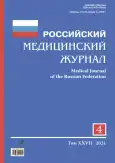«Conscious correction of scoliosis and posture disorders» in the complex rehabilitation treatment of degrees 1–3 thoracic spine idiopathic scoliosis
- Authors: Levkov V.Y.1, Andronova L.B.1, Shavyrin I.A.2, Panyukov M.V.1, Butorina A.V.1, Polyaev B.A.1, Lobov A.N.1
-
Affiliations:
- N.I. Pirogov Russian National Research Medical University
- Scientific and Practical Center of Specialized Medical Care for Children
- Issue: Vol 27, No 4 (2021)
- Pages: 349-354
- Section: Clinical medicine
- URL: https://journals.rcsi.science/0869-2106/article/view/106276
- DOI: https://doi.org/10.17816/0869-2106-2021-27-4-349-354
- ID: 106276
Cite item
Abstract
BACKGROUND: Severe functional disorders in the internal organs and systems of the body, increased fatiguability, and cosmetic body shape defects that lead to social and psychological problems, as well as the potential adverse effect of the progression of scoliotic deformity, necessitate the constant monitoring and timely treatment of sick children until their bone growth is completed. Thus, early diagnostics of scoliosis and timely combination therapy at the early stages of the disease are required.
AIM: This study aimed to compare the efficiency of spinal deformity correction and apical vertebrae derotation in pediatric patients with thoracic spine idiopathic scoliosis and justification of the use of physiotherapy exercise method, “Conscious correction of scoliosis and postural disorders” (DCS) in children and adolescents with degrees 1–3 thoracic spine idiopathic scoliosis (IS).
MATERIALS AND METHODS: This study included 98 patients with IS under supervision (78 (79.6%) females and 20 (20.4%) males). The average age of subjects was 12.5 years (9–16 years), namely 25 patients aged 9–11 years, 42 patients aged 12–14 years old, and 31 patients aged 14–16 years old. The anatomical type of deformity and its parameters were determined according to radiographs and clinical examination data (81 cases of right-sided thoracic scoliosis and 17 left-sided thoracic scolioses). The angular deformity was assessed according to J.R. Cobb, and the angle of curvature was 7°–36°. At baseline, all patients had active growth bone plasticity of the spine. Depending on the degree of deformity, they were distributed into groups of 37 patients with 7°–16°, 33 patients with 17°–22°, and 28 patients with 23°–36°. The radiograph analyses of the spine were performed in frontal and lateral projections in an upright position (frontal and sagittal plane curvature in degree measurements). Radiography was performed before the complex therapy and 2 years thereafter, which included individual isometric, derotation, respiratory, and other complexes of physiotherapy exercises according to the methods of DCS, K. Schroth, and Chêneau corsetting.
RESULTS: The changes over time of scoliotic deformity angle correction are closely related to the time of diagnosis, which was noted in all patient groups under study.
CONCLUSIONS: Early diagnostics of thoracic spine IS and the use of DCS remedial gymnastics within the program of timely conservative treatment eliminated the disease progression in patients with deformity up to 17°. In the case of IS of 20° and more, the combined use of the Chêneau corset and exercise therapy using the DCS method achieved significant stabilization and correction.
Full Text
##article.viewOnOriginalSite##About the authors
Vitaly Yu. Levkov
N.I. Pirogov Russian National Research Medical University
Author for correspondence.
Email: Levkovv@ya.ru
ORCID iD: 0000-0002-4104-2886
MD, Cand. Sci. (Med.), assistant professor
Russian Federation, MoscowLarisa B. Andronova
N.I. Pirogov Russian National Research Medical University
Email: larisaandronova@mail.ru
ORCID iD: 0000-0001-5142-0257
MD, Cand. Sci. (Med.), assistant professor
Russian Federation, MoscowIlya A. Shavyrin
Scientific and Practical Center of Specialized Medical Care for Children
Email: shailya@ya.ru
MD, Cand. Sci. (Med.)
Russian Federation, MoscowMaxim V. Panyukov
N.I. Pirogov Russian National Research Medical University
Email: maxim287@mail.ru
MD, Cand. Sci. (Med.), assistant professor
Russian Federation, MoscowAntonina V. Butorina
N.I. Pirogov Russian National Research Medical University
Email: avbutorina@gmail.com
ORCID iD: 0000-0001-8465-0593
MD, Dr. Sci. (Med.), Рrofessor
Russian Federation, MoscowBoris A. Polyaev
N.I. Pirogov Russian National Research Medical University
Email: polyaev@sportmed.ru
ORCID iD: 0000-0002-9648-2336
MD, Dr. Sci. (Med.), Рrofessor
Russian Federation, MoscowAndrey N. Lobov
N.I. Pirogov Russian National Research Medical University
Email: a_lobov54@mail.ru
ORCID iD: 0000-0003-2088-6139
MD, Dr. Sci. (Med.), Professor
Russian Federation, MoscowReferences
- Andrianov VL, Bairov GA, Sadof’eva VI, Raie RE. Zabolevaniya i povrezhdeniya pozvonochnika u detei i podrostkov. Leningrad: Meditsina; 1985. 256 р.
- Lenke LG, Bridwell KH, Baldus C, et al. Cotrel-Dubousset instrumentation for adolescent idiopathic scoliosis. J Bone Joint Surg Am. 1992;74(7):1056–1067
- Mikhailovskii MV, Fomichev NG. Khirurgiya deformatsii pozvonochnika. Novosibirsk: Sibirskoe universitetskoe izdatel’stvo; 2002. (In Russ).
- Skryabin EG. Relationship of diseases spine and feet in children. Meditsinskaya Nauka I Obrazovanie Urala. 2016;17(2):45–48. (In Russ).
- Isupova OA, Podlubnaya AA. Application kineziotaping the correction of scoliosis. Sciences of Europe. 2016;(11):49–50. (In Russ).
- James JI. The etiology of scoliosis. J Bone Joint Surg Br. 1970;52(3):410–419.
- Levkov VY, Panyukov MV, Andronova LB, et al. Osoznannaya korrektsiya skolioza i narushenii osanki. Nauchno-prakticheskoe rukovodstvo. Moscow; 2020. (In Russ).
- Arshin VV, Chebykin AV. Scoliosis: etiology, pathogenesis and a new method of correction. Vestnik medicinskogo instituta “REAVIZ”: reabilitaciya, vrach i zdorov’e. 2015;(1):55–57. (In Russ).
- Zaydman AM. What is idiopathic scoliosis? Spine Surgery. 2016;13(4):104–110.
- Zaitseva TN. Nizkochastotnoe elektrostaticheskoe pole v kompleksnom lechenii skolioza u detei [dissertation]. Moscow; 2018.
- Dudin MG, Pinchuk DY. Idiopathic Sc Oliosis. Lecture, Part I. "Para doxes". Pediatric Traumatology, Orthopaedics and Reconstructive Surgery. 2014;2(1):70–77. (In Russ). doi: 10.17816/ptors2170-77
- Kiselev DA, Levkov VY, Timonin EM, et al. Method of Using Proprioceptive Correctors. Medical Journal of the Russian Federation. 2019;25(5-6):280–286. (In Russ). doi: 10.18821/0869-2106-2019-25-5-6-280-286
- Plotnikov VP, Polyaev BA, Panyuko MV, Levkov VY. Integral assessment of physical development of college students. Sports Medicine: Research And Practice. 2015;(2):69–74. (In Russ).
- Tsoy SV, Lobov AN, Belyakov VK, et al. Innovative approach to the treatment and correction of scoliosis using a directed psycho-volitional statodynamic system in combination with modern methods of control. Sports Medicine: Research And Practice. 2015;(4):78–82.
Supplementary files








